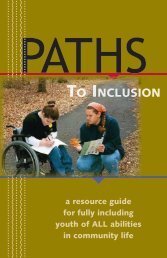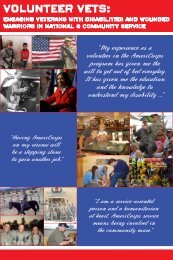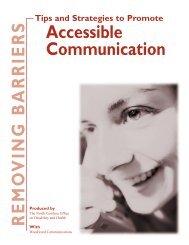Active Citizens 101 - National Service Inclusion Project
Active Citizens 101 - National Service Inclusion Project
Active Citizens 101 - National Service Inclusion Project
You also want an ePaper? Increase the reach of your titles
YUMPU automatically turns print PDFs into web optimized ePapers that Google loves.
Social Capital and<br />
Democracy<br />
Civic Action Guide<br />
MODULE FIVE: SUPPLEMENTAL LESSONS<br />
WHAT’S YOUR PROBLEM<br />
CONTINUED<br />
4. Have each group present its charts.<br />
Hang up each chart and, after all the presentations,<br />
give members time to go up<br />
and look at all of the charts.<br />
Selecting A Problem<br />
1. Regroup and explain that it is now time<br />
to select the problem. Participants should<br />
determine which problem they want to<br />
work on through a vote or show of hands.<br />
2. Once decided, write this problem on this<br />
board and review its causes and effects.<br />
Ask for any additional causes and effects<br />
from the group as a whole.<br />
3. Participants now need to refine the selection<br />
to a workable aspect of the problem.<br />
The selection at this point should be<br />
narrowed to a cause, effect, or smaller<br />
piece of the problem (subproblem). Have<br />
participants brainstorm a list of sub-problems<br />
to add to the list of causes and effects<br />
that has already been generated.<br />
4. You may choose to have members repeat<br />
step 3 (under Cause and Effect); to<br />
further identify causes and effects for each<br />
subproblem.<br />
5. Have participants vote on which subproblem<br />
is most important. This vote determines<br />
the final problem selection.<br />
Cognitive Reflection<br />
Select one or more of the following ideas<br />
for cognitive reflection activities with<br />
participants.<br />
1. During the forced-choice activity, which<br />
of the arguments you heard were the most<br />
convincing and why Have participants<br />
discuss this.<br />
2. Is it more important to address a cause<br />
or effect of a problem Defend your position.<br />
This can be either a group discussion<br />
or a journal entry.<br />
3. Ask others (friends, parents, children,<br />
community members) which problem they<br />
think is the most important to work on and<br />
why.<br />
Follow-up Suggestions<br />
Participants should start researching the<br />
problem using the techniques spelled out in<br />
Handout: “Narrowing Down the Problem.”<br />
DRAFT<br />
45






